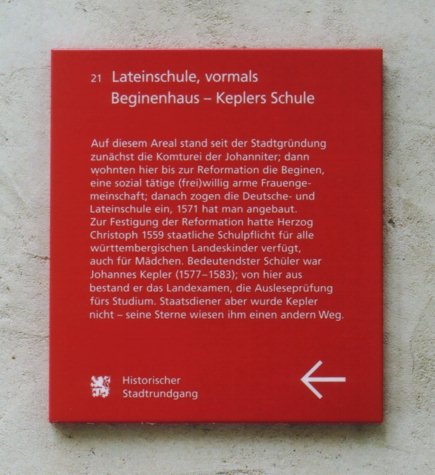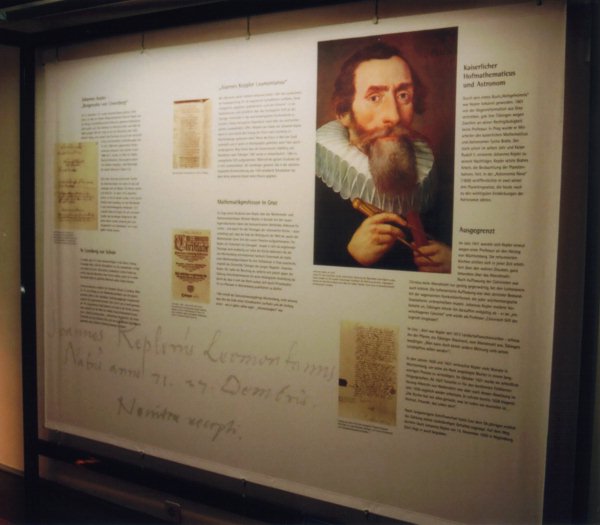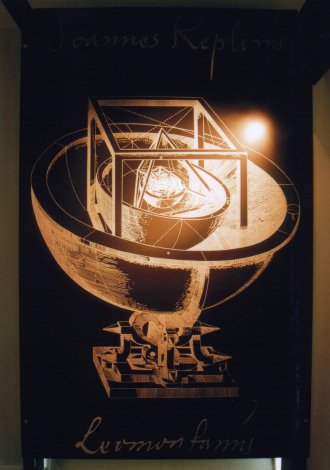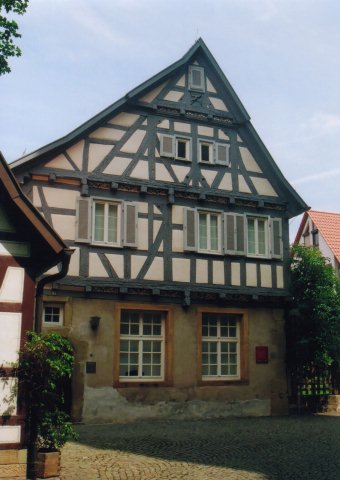

![]() Im Stadtmuseum von Leonberg ist ein Ausstellungsraum für Exponate zu
Johannes
Kepler reserviert (Kepler-Raum). Auf der Tafel am Museumsgebäude wird ebenfalls auf
J. Kepler Bezug genommen; sie zeigt folgenden Text:
Im Stadtmuseum von Leonberg ist ein Ausstellungsraum für Exponate zu
Johannes
Kepler reserviert (Kepler-Raum). Auf der Tafel am Museumsgebäude wird ebenfalls auf
J. Kepler Bezug genommen; sie zeigt folgenden Text:
| Lateinschule, vormals Beginenhaus - Keplers Schule Auf diesem Areal stand seit der Stadtgründung zunächst die Komturei der Johanniter; dann wohnten hier bis zur Reformation die Beginen, eine sozial tätige (frei)willig arme Frauenge- meinschaft; danach zogen die Deutsche- und Lateinschule ein, 1571 hat man angebaut. Zur Festigung der Reformation hatte Herzog Christoph 1559 staatliche Schulpflicht für alle württembergischen Landeskinder verfügt, auch für Mädchen. Bedeutendster Schüler war Johannes Kepler (1577 - 1583); von hier aus bestand er das Landexamen, die Ausleseprüfung fürs Studium. Staatsdiener aber wurde Kepler nicht - seine Sterne wiesen ihm einen anderen Weg. |
Unter diesem Text ist noch das Leonberger Wappentier platziert und der Hinweis "Historischer Stadtrundgang" zu lesen.
Das nachstehend abgebildete Plakat aus dem Kepler-Raum zeigt ein Portät, einzelne Seiten von Dokumenten und textliche Informationen (nachstehend sind die Überschriften aufgezählt)
Im letzten Abschnitt geht es dabei darum, dass Kepler wegen eine Glaubenfrage keine Professur in Wüttemberg erhielt.

Eine Schautafel / Stoffbahn informiert über:
 Eine weitere Stoffbahn zeigt eine Abbildung des
Planetenmodells
aus J. Keplers erstem Werk Mysterium Cosmographicum (siehe auch das
Exponat im Kepler-Museum in Weil der Stadt) zusammen mit
Schriftzügen "Joannes Kepler" und "Leomontanus",
die allerdings links auf dem Bild kaum zu erkennen sind. Weiter unten rechts wird der
Bilderreigen durch eine Ansicht der Gebäudefront mit der Informationstafel
komplettiert.
Eine weitere Stoffbahn zeigt eine Abbildung des
Planetenmodells
aus J. Keplers erstem Werk Mysterium Cosmographicum (siehe auch das
Exponat im Kepler-Museum in Weil der Stadt) zusammen mit
Schriftzügen "Joannes Kepler" und "Leomontanus",
die allerdings links auf dem Bild kaum zu erkennen sind. Weiter unten rechts wird der
Bilderreigen durch eine Ansicht der Gebäudefront mit der Informationstafel
komplettiert.
Die Fotos wurden im Juli 2008 aufgenommen.
![]() The municipal museum of the city of Leonberg possesses one room devoted to exhibits
concerning
Johannes
Kepler and is called Kepler-room. The text on a plaque at the building refers also on
J. Kepler. It reads like:
The municipal museum of the city of Leonberg possesses one room devoted to exhibits
concerning
Johannes
Kepler and is called Kepler-room. The text on a plaque at the building refers also on
J. Kepler. It reads like:
| Lateinschule, formerly Beginenhaus - Keplers school Since foundation of the town this area was used for the commander of the Order of St. John of Jerusalem. Later, up to the Reformation the Beginen lived here. This was a social engaged voluntary poor community of women. Thereafter the German- and Latin-school moved in. In 1571 some addition of the building occured. In 1559 duke Christoph introduced the general (also for girls) compulsory education for the sake of consolidation of the Reformation. Most important pupil was Johannes Kepler (1577 - 1583). He passed the exam and was selected for higher education. But he never became Government employee. His stars showed him another career. |
Below this text the heraldic animal of Leonberg is shown as well the hint "historic round walk.
The poster shown above is provided in the Kepler-room. It shows a portrait, several sheets of documents and textual information. The section's titles are listed in the following)
The last section is concerned with the refusal of a professorship of J. Kepler in Württemberg due to deviating meaning concerning religious faith.
 Another poster informs on
Another poster informs on
Another web of cloth (cf. the last picture above on the left) shows the model from J. Kepler's first work Mysterium Cosmographicum (cf. also the exhibit in the Kepler Museum in Weil der Stadt) together with the characters "Joannes Kepler" and "Leomontanus". The latter may only heavily be recognized on the photograph. Finally on the right a view of the building with the information plaque is provided.
The photographs were taken in July 2008.
1) The German word "Löwe" (plural "Löwen") and the Latin word "Leo" mean both the same, namely lion. (Back to the reference)
| Back to the main page | Created by Wolfgang Volk in December 2009 |